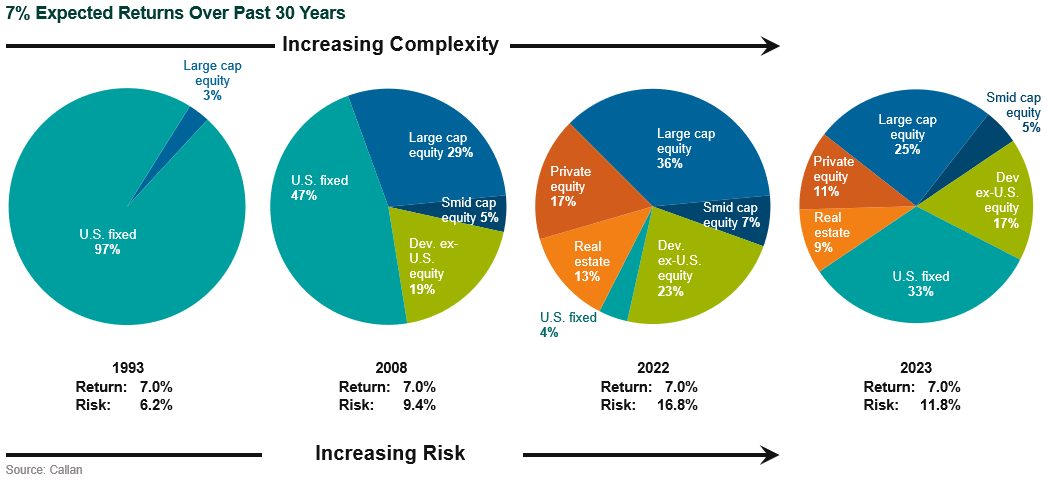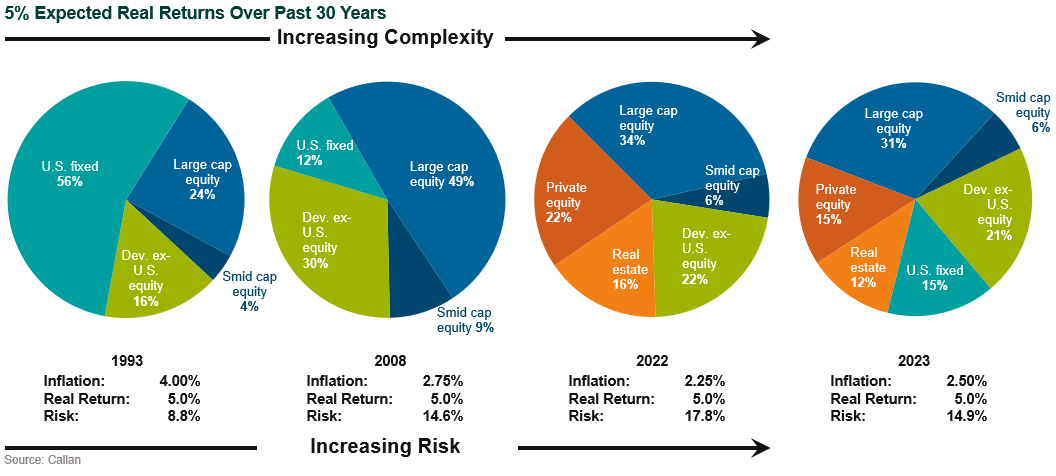In 2016, Callan published “Risky Business,” a paper that focused on the challenges faced by institutional investors in the low return environment they found themselves in (available at the link above). The paper received a lot of attention, including from The Wall Street Journal, largely due to the graphic illustrating what was required in terms of asset allocation to earn a 7.5% expected return over various time periods. Our analysis found that investors in 2015 needed to take on three times as much risk as they did 20 years before to earn the same return.
Given that attention and the interest in our work from the institutional investing community, we wanted to update our analysis once again to reflect current conditions and to extend the comparison over a longer time period.
2022 turned out to be yet another truly historic year as U.S. stock and bond markets fell together for only the third time in a calendar year since 1926. Low interest rates combined with kinks in the supply chain and a war in Ukraine sent inflation soaring across the globe in 2022. Central banks around the world, including the U.S. Federal Reserve, responded by raising borrowing rates in an attempt to slow inflation. In the U.S., the Bloomberg US Aggregate Bond Index fell 13% as higher rates hurt existing bond prices, while the S&P 500 declined 18% as investors became spooked by the growing threat of recession brought about by tightening.
We began the assumption-setting process for 2023 with equity valuations back in line with their historical averages and bond yields that once again made fixed income attractive purely from a return standpoint. Not surprisingly, our 2023 Capital Markets Assumptions differed quite a bit from the prior year, particularly for fixed income. Our core U.S. fixed income assumption rose 250 basis points to 4.25% for the next 10 years on the back of higher starting yields. We bumped our return expectations for public market equity segments by approximately 75 bps from a year earlier, centered around 7.25% for large cap U.S. equity. Returns for private market asset classes rose as well with the exception of private real estate. Finally, we increased our 10-year inflation assumption to 2.50% from 2.25%.
Risky Business 2023: Our Methodology
Coupled with the ongoing threat of a recession and the impact of rising rates and inflation on financial markets, institutional investors continue to face a difficult investing environment. To find out how difficult, our experts examined what it would take for an investor to achieve a nominal 7% expected return over the next 10 years. Using our proprietary Capital Markets Assumptions, we found that investors in 2023 needed to take on approximately twice as much risk as they did 30 years ago.
Return-seeking portfolios are now more complex and expensive than ever. Whereas in 1993 a portfolio made up of 97% bonds and 3% large cap equity was projected to return 7%, by 2023 an investor would need to include two-thirds of the portfolio in return-seeking assets (stocks and private markets) to achieve comparable return expectations. Today’s 7% portfolio is much more reasonable than it was just a year ago, though. In 2022 an investor was required to include 96% of the portfolio in return-seeking assets to earn a 7% expected return, while today a third of the portfolio can be in fixed income.

To be sure, the early ‘90s were a different time, with not only higher fixed income yields but also higher inflation. Therefore, we examined what it would take to earn a 5% real return given our prevailing inflation expectations at the time. The graphic below shows that the pattern of increasing complexity over time remains similar over the 30-year period. Today investors need to take on roughly 1.7x the volatility as they did 30 years ago to earn a 5% real expected return, versus two times the risk just a year ago.

While investors are cautiously optimistic that inflation may be coming under control and we may be able to avoid a recession, uncertainty surrounding what lies ahead and the impact on portfolios is on the minds of many. Whether assessed in a nominal or real framework, our conclusions from our 2016 study remain unchanged: Investors require far more complex and risky portfolios to meet their return targets than they did 30 years ago. While 2023 marks an improvement over the prior year in terms of the risk required to earn a specific return target, clients must continue to assess whether their portfolio’s risk and complexity is appropriate based on their specific circumstances.
Disclosures
The Callan Institute (the “Institute”) is, and will be, the sole owner and copyright holder of all material prepared or developed by the Institute. No party has the right to reproduce, revise, resell, disseminate externally, disseminate to any affiliate firms, or post on internal websites any part of any material prepared or developed by the Institute, without the Institute’s permission. Institute clients only have the right to utilize such material internally in their business.

